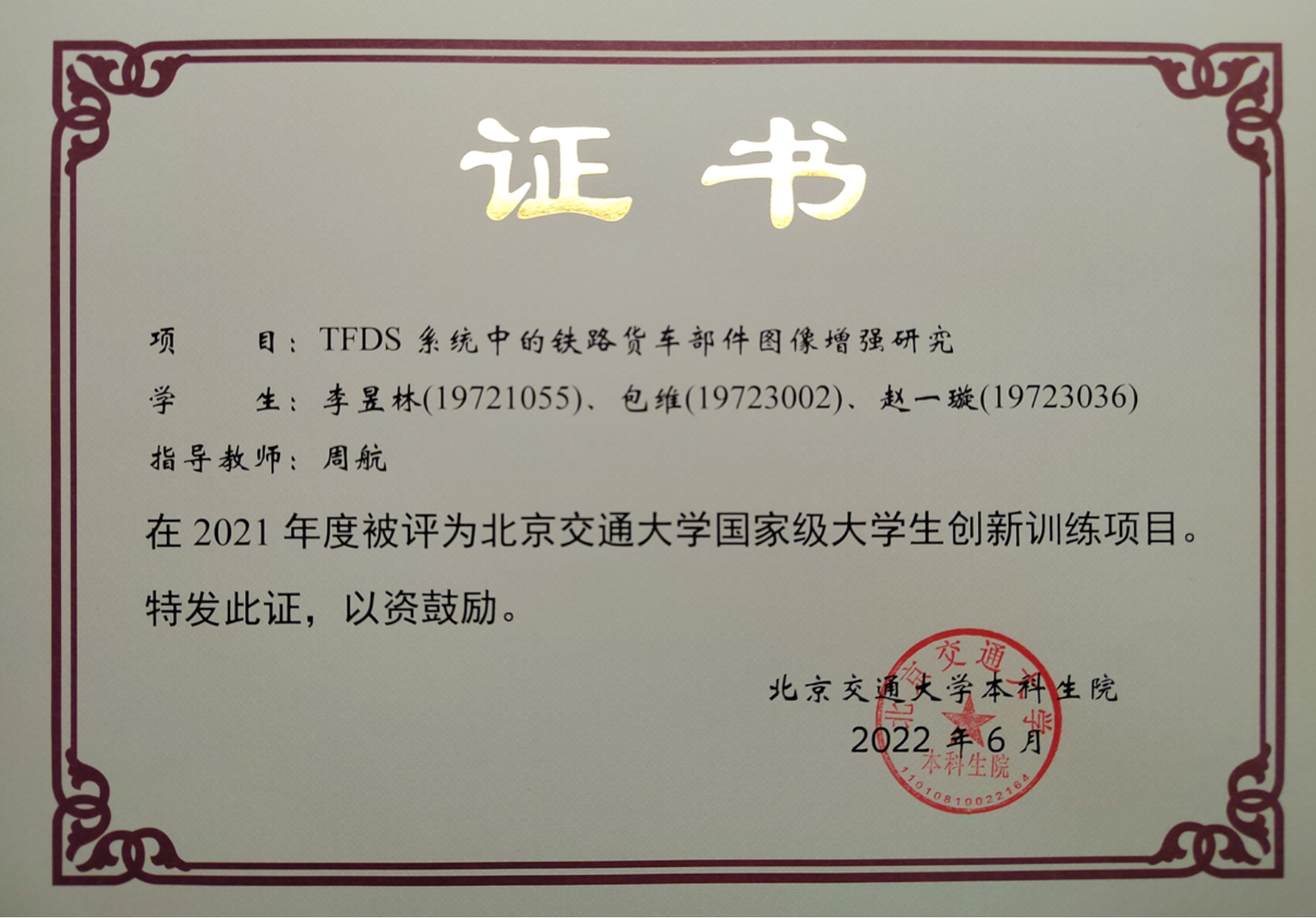In this project, a TFDS image pre-processing method combining image edge enhancement and sparrow search algorithm is proposed to address the problems of underexposure, low contrast and blurred edge details of train images in the Trouble of moving Freight car Detection System (TFDS). The method first uses the Gauss-Laplace operator to detect and sharpen the edges of the image to enhance the sharpness of the edge details of train parts, and then uses the sparrow search algorithm to search for the optimal parameters of the non-complete Beta function to achieve adaptive enhancement of low-illumination images. The experimental results show that the method outperforms common TFDS image pre-processing algorithms in terms of information entropy, average gradient and contrast. This project can reduce the error rate of manual identification in current applications and can be applied to TFDS critical part matching algorithms in future research to achieve intelligent fault identification.
Project Team Members:
Li Yulin, Class of 2019, Communication Engineering
Bao Wei, Class of 2019, Communication Engineering
Zhao Yixuan, Class of 2019, Environmental Engineering
Instructor: Zhou Hang
Project Level: National Level
Project Introduction:
In this project, to address issues such as insufficient exposure, low contrast, and blurred edge details in the Trouble of moving Freight car Detection System (TFDS) images, a TFDS image preprocessing method combining image edge enhancement and the Sparrow Search Algorithm (SSA) is proposed. The project workflow is as follows: First, the Gaussian-Laplacian operator is used for edge detection and sharpening to enhance the clarity of edge details of train components. Second, the Sparrow Search Algorithm is employed to find the optimal parameters for the incomplete Beta function. Finally, adaptive enhancement of low-illumination images is achieved. Experimental results show that this method outperforms commonly used TFDS image preprocessing algorithms in terms of information entropy, average gradient, and contrast. This project can currently reduce the error rate of manual identification and, in future research, can be applied to TFDS key part matching algorithms to achieve intelligent fault recognition.
Project Innovations:
1.Improved image quality through programming, reducing costs.
2.Replaced traditional optimization algorithms such as simulated annealing and artificial bee colony.
3.Enhanced the adaptive image enhancement method based on the Sparrow Search Algorithm.
Project Outcomes:
1.Completed the design of an algorithm for enhancing low-illumination TFDS images.
2.Completed the paper titled "An Adaptive Enhancement Method for TFDS Images Combining Image Edge Enhancement and Sparrow Search Algorithm." The paper was submitted to the domestic academic journal "Information and Computer" and has been indexed by databases such as CNKI, VIP, and Wanfang.
Demonstration of Algorithm Processing Effects:
Fig. 1a original picture; Fig. 1b CLAHE processing diagram; Fig. 1c MSR processing diagram; Fig. 1d is an unsharp mask processing diagram; Fig. 1e is the processing diagram of this algorithm.
Fig. 1 enhancement effect of different algorithms on part sample 1
Fig. 2a original gray histogram; Fig. 2b CLAHE processes the gray histogram; Fig. 2c MSR process gray histogram; Fig. 2d unsharp mask processing gray histogram; Fig. 2e The algorithm in this paper processes the gray histogram. Fig. 2 Gray histogram of sample I of parts processed by different algorithms
Fig. 3a original picture; Fig. 3b CLAHE processing diagram; Fig. 3c MSR processing diagram; Fig. 3d processing diagram of unsharp mask; Fig. 3e is the processing diagram of this algorithm. Fig. 3 the enhancement effect of different algorithms on part sample 2.
Fig. 4a is the gray histogram of the original image; Fig. 4b CLAHE processes the gray histogram; Fig. 4c MSR process gray histogram; Fig. 4d is a grayscale histogram processed by unsharp mask; Fig. 4e The algorithm in this paper deals with gray histogram. Fig. 4 Gray histogram of sample 2 of parts processed by different algorithms.
Fig. 5a original drawing; Fig. 5b CLAHE processing diagram; Fig. 5c MSR processing diagram; Fig. 5d is an unsharp mask processing diagram; Fig. 5e is the processing diagram of this algorithm. Fig. 5 the enhancement effect of different algorithms on the processing of part sample 3.
Fig. 6a original gray histogram; Fig. 6b CLAHE processes the gray histogram; Fig. 6c MSR processes the gray histogram; Fig. 6d unsharp mask processing gray histogram; Figure 6e The algorithm in this paper processes gray histogram. Fig. 6 Gray histogram of sample 3 of parts processed by different algorithms.
Fig. 7a original picture; Fig. 7b CLAHE processing diagram; Fig. 7c MSR processing diagram; Fig. 7d is a processing diagram of unsharp mask; Fig. 7e is the processing diagram of this algorithm. Fig. 7 Enhancement Effect of Different Algorithms on Part Sample 4
Fig. 8a original gray histogram; Fig. 8b CLAHE processes the gray histogram; Fig. 8c MSR processes the gray histogram; Fig. 8d unsharp mask processing gray histogram; Fig. 8e The algorithm in this paper processes the gray histogram. Fig. 8 Gray histogram of sample 4 of parts processed by different algorithms.


